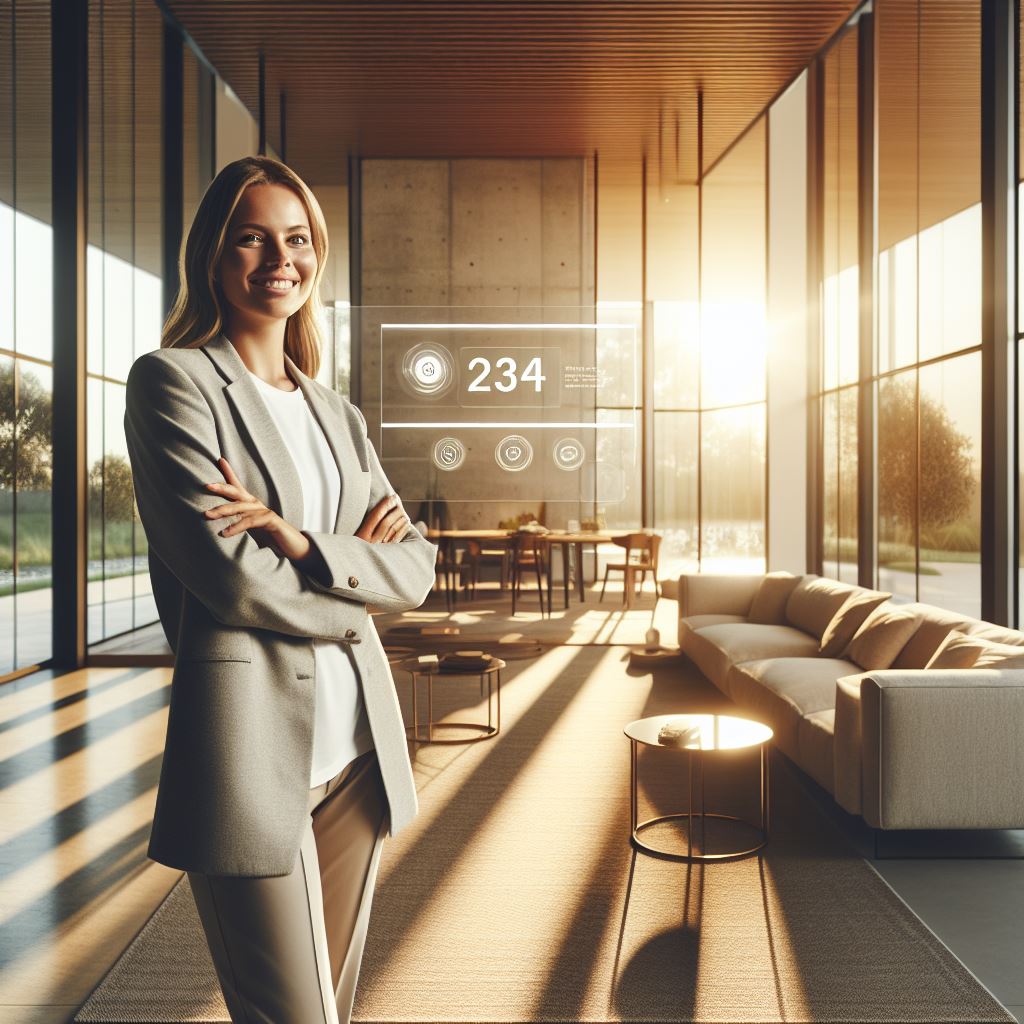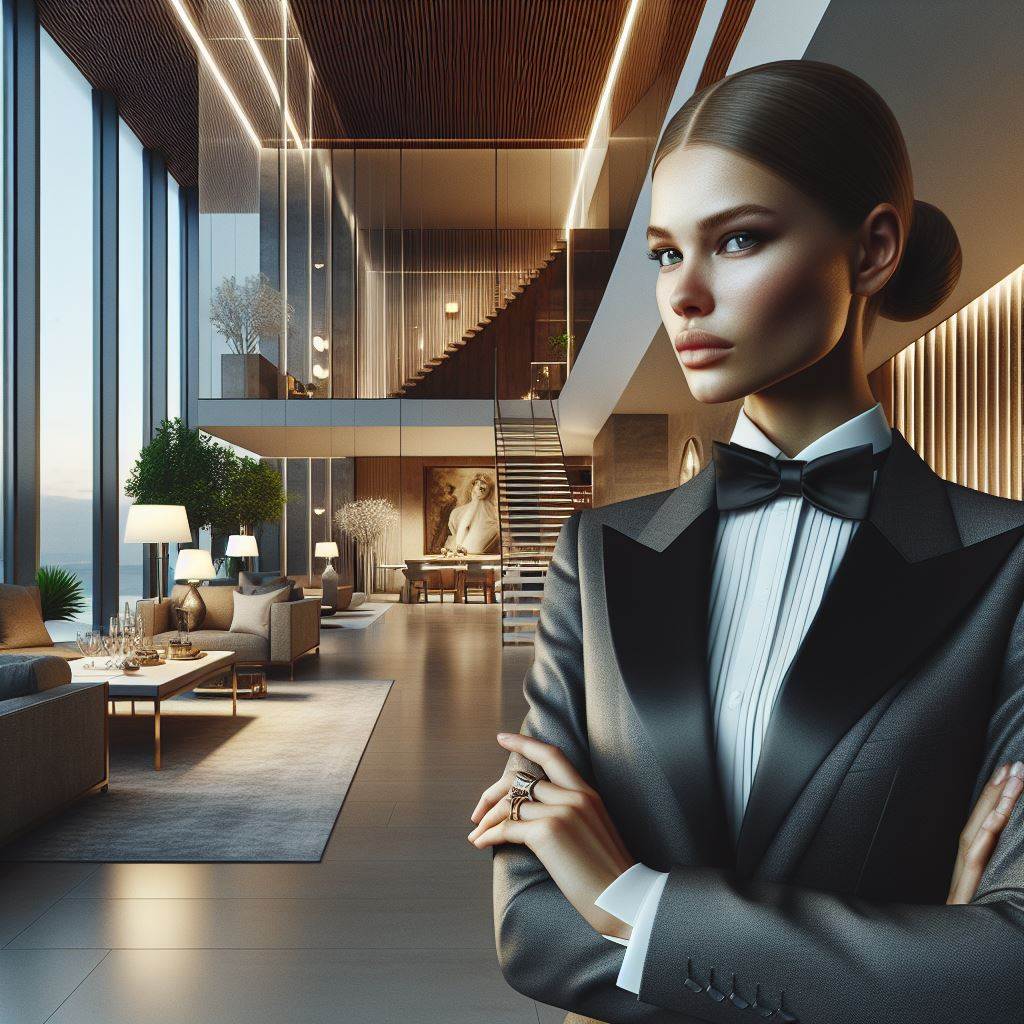Introduction
Home design trends are not merely aesthetic choices; they significantly influence how we inhabit and interact with our living spaces.
From layout to décor, these trends reflect evolving lifestyles, preferences, and technological advancements, making them a crucial aspect of contemporary living.
As we navigate the dynamic landscape of home design, the year 2024 emerges as a focal point for exploring current trends.
In this rapidly evolving era, marked by rapid technological advancements and shifting societal values, homes are transforming into multifunctional sanctuaries that cater to diverse needs.
In 2024, we bear witness to a surge in innovative design concepts that prioritize functionality, comfort, and sustainability.
From adaptable furniture to energy-efficient appliances, homeowners are embracing solutions that enhance both their quality of life and environmental footprint.
This shift towards sustainability extends beyond mere materials; it encompasses holistic design approaches that integrate renewable energy systems, green spaces, and passive cooling techniques.
Moreover, technology continues to revolutionize home design, with smart home features becoming increasingly ubiquitous.
From automated lighting and climate control systems to AI-powered assistants, homes are seamlessly integrating technology to streamline daily routines and enhance convenience.
However, alongside these advancements, a renewed appreciation for craftsmanship and artisanal techniques is also evident in contemporary home design.
Handcrafted furniture, bespoke finishes, and personalized touches add warmth and character to modern interiors, offering a counterbalance to the ubiquity of mass-produced goods.
Furthermore, the concept of wellness-driven design is gaining traction, with homeowners prioritizing spaces that promote physical and mental well-being.
Biophilic design principles, natural light optimization, and ergonomic furniture contribute to creating harmonious environments that nurture both body and soul.
In this post, we will delve into the intricacies of these emerging trends, exploring their impact on residential architecture, interior design, and the way we experience home.
From sustainable practices to cutting-edge technology, the home design landscape of 2024 is a testament to our evolving aspirations and the boundless possibilities of creative ingenuity.
Sustainability and Green Living
A. Growing interest in eco-friendly home design
Homeowners are becoming increasingly conscious of their environmental impact and are seeking sustainable design options.
Green living has become a significant consideration for homebuyers, leading to a rising demand for eco-friendly homes.
People are embracing the concept of designing homes that minimize their carbon footprint.
B. Incorporation of sustainable materials and energy-efficient technologies
Sustainable materials like bamboo, reclaimed wood, and recycled steel are gaining popularity in home design.
These materials are not only environmentally friendly but also stylish and durable.
Energy-efficient technologies such as solar panels, smart thermostats, and LED lighting are being integrated into home designs.
These technologies help reduce energy consumption and lower utility costs, making homes more sustainable.
C. Increase in demand for homes that promote a healthier lifestyle
Homeowners now prioritize their well-being and are seeking homes that foster a healthier lifestyle.
The incorporation of natural lighting and ventilation systems ensures better indoor air quality.
Biophilic design, which incorporates elements of nature into the home, has gained significant attention.
Green spaces like rooftop gardens and indoor plants are becoming common features in modern homes.
D. Benefits of sustainable home design
Energy efficiency in homes leads to reduced carbon emissions and lower energy bills.
Sustainable homes contribute to a healthier environment by reducing waste and conserving resources.
By using eco-friendly materials, homeowners can create a chemical-free living environment.
Sustainable design promotes a healthier lifestyle, leading to improved physical and mental well-being.
E. Tips for incorporating sustainability into home design
- Use energy-efficient appliances and fixtures to reduce energy consumption.
- Utilize sustainable building materials such as recycled glass or cork flooring.
- Install a rainwater harvesting system to conserve water resources.
- Maximize natural lighting and ventilation to reduce dependency on artificial lighting and air conditioning.
- Incorporate landscaping with native plants that require less water and maintenance.
In 2024, sustainability and green living will dominate home design trends.
Homeowners will prioritize eco-friendly materials, energy efficiency, and the promotion of a healthier lifestyle.
By embracing sustainable home design, individuals can contribute to a greener future while enjoying the benefits of a modern, stylish, and healthy living space.
Read: Climate Change’s Role in 2024 Housing Trends
Biophilic Design
A. Integration of nature and natural elements into interior design
The use of biophilic design in interior spaces has gained significant popularity in recent years.
This design approach involves incorporating elements of nature and natural elements into the structure and layout of a home.
Biophilic design seeks to create a connection between human beings and the natural environment, resulting in a more calming and relaxing living space.
B. Use of elements like plants, natural light, and organic materials
One key aspect of biophilic design is the integration of plants into indoor spaces.
From potted plants to living walls, the presence of greenery brings a sense of freshness and serenity to any room.
In addition, ample natural light is also a vital component of biophilic design.
Large windows and skylights allow sunlight to flood the space, enhancing the overall ambiance and creating a sense of openness.
Furthermore, the use of organic materials is another hallmark of biophilic design.
Incorporating natural materials such as wood, stone, and bamboo into the architecture and furnishings adds warmth and texture to the living space.
These materials create a sense of harmony and connection with nature, which contributes to an overall sense of well-being.
C. Benefits of biophilic design on mental and physical well-being
Biophilic design has numerous benefits for both mental and physical well-being.
Studies have shown that exposure to natural elements, such as plants and natural light, can reduce stress levels and promote relaxation.
The presence of greenery has also been linked to improved air quality and increased oxygen levels, which can have positive effects on respiratory health.
Furthermore, the use of organic materials in biophilic design promotes a connection to nature, which in turn enhances mood and overall happiness.
The calming effect of natural elements has been proven to increase productivity and creativity.
Additionally, biophilic design has been associated with better sleep quality, as the presence of plants and natural materials can create a more peaceful and restful environment.
In fact, biophilic design is a prominent trend dominating the home design landscape in 2024.
Its integration of nature and natural elements into interior spaces creates a harmonious and calming living environment.
The use of plants, natural light, and organic materials not only enhances the aesthetic appeal of a home but also has significant positive effects on mental and physical well-being.
Embracing biophilic design can greatly improve the overall quality of life within a home.
Read: Rental Market Forecasts for 2024 in the US
Minimalism and Decluttering
A. Rise of minimalistic home design
In 2024, minimalistic home design is anticipated to dominate the design trends.
This design philosophy focuses on simplicity, functionality, and eliminating excess.
Designers and homeowners are increasingly embracing minimalist aesthetics, which prioritize open, uncluttered spaces.
This trend is driven by a desire for tranquility, harmony, and a break from the chaos of modern life.
Minimalism promotes the use of a few essential elements rather than an abundance of decor.
By adopting this approach, homes can feel serene, organized, and visually pleasing.
B. Emphasis on open spaces, clean lines, and simplicity
One of the key features of minimalist design is the emphasis on open spaces.
This includes removing unnecessary walls and creating a seamless flow between rooms.
Open floor plans are becoming increasingly popular as they create a sense of spaciousness and allow for better natural light penetration.
Clean lines and simplicity are also essential in a minimalist design.
This means opting for furniture and decor with sleek designs and minimal embellishments.
The color palette in minimalist homes is typically neutral, with white and light shades dominating.
This enhances the feeling of spaciousness and allows any pops of color to stand out.
C. Ways to incorporate decluttering principles into home organization
Decluttering is a fundamental principle of minimalism. It involves getting rid of unnecessary items and keeping only what is essential and brings joy.
To incorporate decluttering principles into home organization, follow these tips:
- Start with a thorough decluttering process. Go room by room and ask yourself if each item is necessary and adds value to your life. Donate or sell items you no longer need.
- Maximize storage solutions. Invest in multifunctional furniture with hidden storage compartments. Utilize wall-mounted shelves, hooks, and bins to keep items organized and off surfaces.
- Adopt the “one in, one out” rule. When bringing a new item into your home, let go of one similar item. This prevents excessive accumulation and helps maintain a clutter-free environment.
- Create designated spaces for specific items. Assign a home for everything, from shoes to kitchen utensils. This helps reduce clutter and promotes ease of finding and putting things away.
- Regularly reassess and declutter. Make it a habit to review your belongings periodically. This allows you to identify items that no longer serve a purpose and keeps clutter from creeping back in.
By incorporating these decluttering principles, you can achieve a minimalist and organized home.
Remember, simplicity and open spaces are the key components of this design trend.
Smart Home Technology
Smart Home Technology has been rapidly advancing in recent years, and in 2024, we can expect to see even more exciting developments in this field.
Home automation systems are becoming more sophisticated, offering homeowners a higher level of control and convenience.
A. Advancements in home automation systems
Advancements in home automation systems have made it easier than ever for homeowners to manage their homes.
With the integration of AI and voice control, smart homes are becoming more intuitive and responsive to users’ needs.
Imagine walking into your home and having the lights automatically turn on, the temperature adjust to your preferred setting, and your favorite music playing softly in the background.
With smart home technology, this can become a reality.
B. Integration of artificial intelligence and voice control
One of the key trends in smart home technology is the integration of artificial intelligence.
AI-powered virtual assistants, like Amazon’s Alexa and Google Assistant, are becoming increasingly popular and are being integrated into more and more smart home systems.
Through voice control, homeowners can now easily interact with their smart homes.
They can ask their virtual assistant to turn on the lights, play a specific song, or even order groceries online.
The possibilities are endless, making life more convenient and enjoyable.
C. Benefits of smart homes in terms of convenience and energy saving
Smart homes offer a range of benefits in terms of convenience and energy saving.
For example, with a smart thermostat, homeowners can easily adjust the temperature of their homes from anywhere using their smartphones.
This not only allows for a comfortable living environment but also helps to reduce energy consumption and lower utility bills.
Smart lights and appliances can also be controlled remotely, ensuring that no energy is wasted when they are not in use.
Security is another area where smart home technology has made significant strides.
Smart door locks and security cameras can be controlled and monitored remotely, providing homeowners with peace of mind.
Smart home technology also allows for better integration between different systems in the home.
For example, lighting, heating, and security systems can all be connected and controlled through a single interface or app.
As smart home technology continues to evolve, we can expect to see even more innovative features and capabilities.
From smart mirrors that provide personalized beauty tips to refrigerators that can automatically order groceries when supplies run low, the possibilities are truly endless.
In short, smart home technology is set to dominate the home design trends in 2024.
Advancements in home automation systems, the integration of artificial intelligence and voice control, as well as the benefits in terms of convenience and energy saving, make smart homes an attractive option for homeowners.
With the rapid pace of technological development, smart homes are only going to become smarter and more accessible in the coming years.
Read: Urban vs Rural: 2024 Real Estate Outlook

Multifunctional Spaces
A. Growing need for flexible and adaptable living areas
The modern lifestyle demands spaces within the home that can adapt to various activities and functions.
People are looking for versatile spaces that can serve multiple purposes.
B. Furniture and designs that maximize limited space
In homes where space is limited, the importance of furniture and designs that can maximize every inch becomes crucial.
Multifunctional furniture and clever design solutions are gaining popularity.
C. Examples of multifunctional rooms like home offices or guest bedrooms
Home offices, once a luxury, have become a necessity in the digital age.
Many homeowners are turning their spare rooms or even their living rooms into functional workspaces.
Guest bedrooms, on the other hand, are no longer just for guests.
These rooms are now designed to serve multiple functions, such as a home gym, a playroom for kids, or a relaxation space.
1. Multifunctional home offices
In 2024, more professionals are working remotely, which has resulted in the need for dedicated home offices.
These spaces are designed to be functional work areas with all the necessary equipment and storage solutions.
Additionally, multifunctional home offices are being created with integrated features like foldable desks, hidden storage units, and convertible furniture that can transform the space into a guest room if needed.
2. Guest bedrooms with dual functionality
Gone are the days when guest bedrooms remained unused most of the year.
In 2024, these rooms are being designed to serve as more than just a temporary resting place for visitors.
For example, a guest bedroom can also function as a mini home gym, equipped with workout equipment and space for yoga or pilates.
The room can be easily transformed back into a guest bedroom when needed.
Another popular option is turning a guest bedroom into a playroom for children, complete with storage for toys and interactive play areas.
This allows the space to be used by the family even when there are no guests.
3. Creative solutions for limited spaces
With the increasing cost of real estate, many homeowners are living in smaller houses or apartments.
This necessitates creative design solutions to make the most out of limited spaces.
Convertible furniture, such as sofa beds or wall beds, allows for a seamless transition between living room and bedroom.
Foldable and expandable dining tables are also popular choices for maximizing dining spaces.
Furthermore, storage solutions that utilize vertical space, like wall-mounted shelves or hanging organizers, help declutter and organize smaller rooms.
In general, multifunctional spaces are dominating home design trends in 2024.
The growing need for flexible living areas has led to the rise of furniture and designs that maximize limited space.
Home offices and guest bedrooms are no longer single-purpose rooms; they serve multiple functions.
With creative solutions and versatile furniture, homeowners can make the most out of their homes, adapting to the demands of modern living.
Read: The Future of Suburban Homes: 2024 Trends
Bold Colors and Patterns
A. Shift towards vibrant and expressive color schemes
In 2024, home design trends are embracing bold colors that express individuality and create striking statements.
Homeowners are moving away from subtle neutral palettes and gravitating towards vibrant hues.
From rich blues and fiery reds to playful yellows and energetic greens, homes are becoming more visually stimulating.
B. Popular patterns and design trends for 2024
Alongside bold color choices, patterns are taking center stage in home design for 2024.
Geometric patterns, including chevron and herringbone, are becoming increasingly popular.
These patterns add a sense of movement and visual interest to any space.
Floral patterns are also making a comeback, offering a touch of elegance and freshness to interior design.
Whether it’s through wallpapers, fabrics, or accent pieces, patterns are being utilized to create unique and personalized spaces.
C. Balancing bold choices with harmonious aesthetics
While bold colors and patterns are dominating the home design scene in 2024, striking a balance is key.
Combining bold elements with harmonious aesthetics ensures that the overall look remains cohesive and pleasing to the eye.
One way to accomplish this is by using bold colors or patterns as accents, rather than overwhelming the entire room.
For example, a vibrant accent wall can be paired with complementary neutrals to create a visually balanced space.
Similarly, using bold patterns sparingly as statement pieces can add character without overpowering the design.
In 2024, home design trends are all about embracing bold colors and patterns to create visually stimulating spaces.
From vibrant hues to eye-catching patterns, homeowners are infusing their homes with personality and individuality.
By striking a balance between bold choices and harmonious aesthetics, these trends can be incorporated into any home design style.
Versatile Outdoor Living
A. Expansion of living spaces beyond the walls of the house
With the changing trends in home design, outdoor living spaces are becoming an integral part of every home.
Families are now looking to expand their living spaces beyond the traditional walls of the house.
These outdoor areas are designed to be functional and provide the perfect space for relaxation, entertainment, and spending quality time with loved ones.
Outdoor living spaces are no longer limited to a small patio or deck area.
Homeowners are now incorporating larger outdoor areas into their designs, such as expansive decks, covered patios, and even rooftop gardens.
These spaces are designed to seamlessly blend with the indoor areas, creating a harmonious flow between the indoors and outdoors.
The expansion of living spaces beyond the walls of the house allows homeowners to make the most of their outdoor areas and enjoy the natural beauty surrounding their homes.
Whether it’s a serene garden, a breathtaking view, or a sparkling pool, these outdoor spaces provide a perfect retreat from the hustle and bustle of everyday life.
B. Outdoor kitchens, lounges, and versatile seating arrangements
In addition to expanding the living spaces, outdoor kitchens are also gaining popularity in 2024.
Homeowners are now creating fully equipped kitchens in their outdoor areas, complete with grills, sinks, refrigerators, and even pizza ovens.
These outdoor kitchens not only allow for convenient cooking and dining, but they also provide a unique and enjoyable experience for homeowners and their guests.
Lounges and versatile seating arrangements are also becoming a staple in outdoor living spaces.
Comfortable outdoor furniture, such as sofas, loungers, and dining sets, are now designed to withstand the elements while providing maximum comfort and style.
Homeowners can now create cozy seating areas for relaxing, socializing, and dining, just like they would indoors.
C. Importance of landscaping and garden design in creating cohesive outdoor spaces
Creating cohesive outdoor spaces is not just about expanding the living areas or adding trendy features.
Landscaping and garden design play a crucial role in enhancing the overall aesthetic and functionality of these outdoor spaces.
Proper landscaping helps to create a seamless transition between the house and the surrounding environment, while also adding beauty and visual appeal.
Homeowners are now investing in professional landscaping services to design their outdoor spaces with precision.
The use of hardscaping elements, such as paved pathways, stone walls, and water features, can create a sense of structure and define different areas within the outdoor space.
Additionally, the selection of plants, flowers, and trees adds color, texture, and fragrance to the outdoor areas, enhancing the overall ambiance.
Garden design is another important aspect of creating cohesive outdoor spaces.
Homeowners are now recognizing the importance of well-designed gardens in complementing the overall aesthetic of their outdoor living areas.
From formal gardens with neatly trimmed hedges and geometric patterns to naturalistic gardens with native plants and wildflowers, there are numerous garden design styles to choose from.
The aim is to create a garden that harmonizes with the surrounding landscape and enhances the overall outdoor living experience.
In a nutshell, versatile outdoor living is taking center stage in home design trends in 2024.
Families are expanding their living spaces beyond the walls of the house, incorporating outdoor kitchens, lounges, and versatile seating arrangements.
The importance of landscaping and garden design cannot be overstated in creating cohesive outdoor spaces that seamlessly blend with the indoor areas.
With these trends, homeowners can now enjoy the beauty of nature while making the most of their outdoor living areas.
Conclusion
A. Recap of the home design trends dominating in 2024
2024 has seen several home design trends take center stage. Open floor plans continue to be popular, providing a spacious and versatile living area.
Clean lines and minimalist aesthetics have also gained traction, creating a sleek and modern look.
Natural materials like wood and stone are widely used for a warm and organic feel.
Smart homes are becoming increasingly popular, with advanced technology seamlessly integrated into every aspect of daily life.
From automated lighting and temperature control to voice-activated appliances, the possibilities are endless.
Eco-friendly design is also on the rise, with a focus on sustainable materials, energy-efficient systems, and waste reduction.
B. Encouragement to explore and incorporate these trends in personal home design
With these trends dominating the home design landscape in 2024, it is an exciting time to explore new possibilities and incorporate them into personal spaces.
Embracing open floor plans, clean lines, and natural materials can give any home a fresh and contemporary look.
Integrating smart technology and eco-friendly elements can enhance convenience and sustainability.
C. The ever-evolving nature of design trends and the importance of personal preferences and individuality
Design trends are continually evolving, influenced by cultural shifts, technological advancements, and individual preferences.
While it is essential to stay informed about the latest trends, it is equally important to prioritize personal preferences and individuality.
Creating a home that reflects one’s unique personality and lifestyle will always stand the test of time.
Embracing the home design trends dominating in 2024 offers a chance to create a living space that is both stylish and functional.
By incorporating these trends while staying true to personal preferences, individuals can enjoy a home that is a true reflection of their unique identity.




